So. Anyone remember
Super Mario Bros. 2? Sure you do. Back in 1988, all of us young NES enthusiasts simply assumed it was another "black sheep" NES sequel like
Adventure of Link or
Simon's Quest and ran with it. In actuality (for anyone
still not in the know), the North American version of
Super Mario Bros. 2 is the product of a diabolical switcheroo perpetrated by Nintendo of America. Originally, the
Mario 2 with which most of us are familiar was a Japanese Famicom game called
Doki Doki Panic. Nintendo only made a few tweaks to the game here and there, altered the cast's sprites to look like
Mario Bros. characters, then unloaded it on American toy stores as the hotly-anticipated sequel to
Super Mario Brothers.
Why would they do such a thing? Because the Nintendo higher-ups worried that the the
actual sequel to
Super Mario Bros. (better known stateside as
Super Mario Bros.: The Lost Levels) would be too difficult for American audiences. One can't help but feel a little offended, but they had a point. In all fairness, the "real"
Super Mario Bros. 2 wasn't
that much of a loss, especially considering what we got in its place.
Mario Bros. 2 feels more like an expansion pack instead of a fully fledged sequel. It recycles graphics, plays nearly exactly the same, and brings virtually nothing new to the table except a sense that the programmers have it out for the players. Every addition to
Super Mario Bros. 2 (with the one exception of Luigi's higher jump) was designed to make the player's life more difficult, from poison mushrooms to Piranha Plants that don't play by Pirhana Plant rules to
backwards fucking warp zones. I'll take a doctored
Doki Doki Panic any day, thank you.
How does any of this relate to
Final Fantasy, you ask? Well, Square pulled similar tricks on its North American audiences with their early
Final Fantasy releases, and did so much more often than Nintendo. Mention
Final Fantasy II to most casual or former gamers who owned an SNES back when they were kids, and they're likely to answer, "yeah, that was the game with Cecil and that jumping guy! I remember! Awesome!" But this is incorrect. The game they're thinking of is
Final Fantasy IV, which got renamed
Final Fantasy II (to spare you any confusion, we'll refer to it as
Final Fantasy "2" from now on) when it came across the Pacific. The real
Final Fantasy II is an 8-bit Famicom game that only recently hit American shores in the
Final Fantasy Origins and
Dawn of Souls collections on PSOne and GBA. Remember, the original
Final Fantasy reached America in 1990 -- three years after it came out in Japan and one year before the SNES and
Final Fantasy IV hit the market. Localizing and releasing a new game for a new system made much more sense than localizing and releasing an old game for an outdated system that probably wouldn't make much money. Besides,
Final Fantasy II is very much like the original
Super Mario Bros. 2 in its evident eagerness to pound the player into timorous submission. You've got to wonder what was discussed at that important SquareSoft staff meeting in early 1988: "okay, so we have a runaway RPG hit on our hands and we need to make a sequel while there's still interest. I think our goal for
Final Fantasy II should be to make as many people as unhappy as possible, and we can begin by revamping the mechanics so that the most efficient way of increasing your characters' stats is to have them beat the hell out of each other in battle. Sound good to you folks?"

But I may be getting ahead of myself here.
Discussing
Final Fantasy II at any length is impossible without bringing up a developer named Akitoshi Kawazu, who joined SquareSoft in 1985 and helped design
Final Fantasy I and
II. Tim Rogers will tell you all you really need to know about Kawazu in his old
Romaning SaGa: Minstrel Song review, but it will suffice to say here that Kawazu is the best kind of game designer the the sense that he is a true auteur: every game with his name on it bears his unique signature, and could never be mistaken for the work of anyone else. He is also the worst kind of game designer in the sense that his games are never much fun.
Sakaguchi and Kawazu are living representations of the Japanese RPG's Yin and Yang. Sakaguchi relishes telling stories and designing worlds, while Kawazu lives to subject players to grinding, guesswork, and arbitrary chance. Sakaguchi wants to make a game that keeps you up at night; his aim is to compel to decide that you'd rather be deprived of rest than have to wait until you return from school or work the next day to find out what happens next, discover where the path leads, and unravel the next knot of the mystery. Kawazu wants his games to make you throw down the controller in a rage, shut the game off, go to sleep angry, and come home the next afternoon to give it another go like a black-eyed housewife convinced she
can make it work this time.
The original
Final Fantasy is certainly not a breeze. It requires patience, trial, and error to complete, but it's never unreasonable.
Final Fantasy II, on the other hand, is a game that hates your guts. It seems conscientiously designed to be as frustrating as possible -- to be an arduous test of the player's resolve from the opening screen to the closing credits. Kawazu does not want you to play
Final Fantasy II. He wants you to
work through Final Fantasy II.
My experience with Kawazu beyond
Final Fantasy is relatively limited, as I can only bring myself to play a given
SaGa game for a few hours before getting too bored and fed up to continue. From what I've seen, the most telling moment of Kawazu's design philosophy occurs in
Final Fantasy XII, whose development he commandeered after Yasumi Matsuno went AWOL. The weapon with the highest attack power in
XII is the Zodiac Spear. It's not necessarily the most effective weapon, but its having the biggest number attached to it makes it the sweetest plum to an RPG completionist. The Zodiac Spear sits in a treasure chest in an optional dungeon. There's no horrible super boss that must be fought before you earn it, and there's no grinding or sidequests required to access the dungeon. All you have to do is find the room with the chest in it and press the X button.
This assumes, however, that you didn't make the mistake of opening up any of the
wrong treasure chests before reaching the area where the Zodiac Spear is found. There are four of these chests: three appear toward the beginning of the game, when your team is weak, broke, low on items, and needs all the help it can get, while the fourth pops up somewhere around the middle. These chests have no special markings, they contain common items, and there is nothing about them to indicate that they might have "switches" attached to them that can turn the Zodiac Spear chest off. If you happen to open even
one of these totally nondescript, easy-to-find treasure chests while playing this game in which you're supposed (and expected) to open every chest you find, the Zodiac Spear gets blinked out of existence.

You have to ask yourself why Kawazu would do this when he knew damn well there were thousands of RPG geeks who would go into conniptions after putting sixty hours into
Final Fantasy XII and discovering that they blew their chance at getting the strongest weapon in the game within the first forty-five minutes. The only explanation is that he's a spiteful troll disguised as a legitimate video game developer. Kawazu is the type of person who designs those
sadistic Super Mario hacks, only he happens to be an executive at one of the world's biggest and most influential video game companies.
In Kawazu's defense, there's something to be said for an RPG designer dedicated to making games that are impossible to coast through, and his experiments in hotwiring the number-driven mechanisms by which an RPG is governed (notice how those
Mario hacks were similarly designed by people with a deeper understanding of game engine than the people who actually created it), were undeniably ahead of their time. But ultimately, he seems a lot more interested in tinkering with mechanics for tinkering's sake than making games that people without autism might enjoy playing.
Final Fantasy II is where it began. This is the very first Kawazu game. It should not come as much of surprise that it also happens to be the weakest of the old-school
Final Fantasy games, and the last one Kawazu was allowed to touch for fifteen years. Overseas players who got
Final Fantasy "2" instead were
not missing out.
THE CAST!Unlike the first game,
Final Fantasy II features player characters with their own voices and personalities. The cast isn't anywhere near as extensively developed as those from later installments (actually, they're downright one-dimensional), but progress is progress. The permanent team consists of Frioniel, Maria, and Guy, while the fourth "visitor" slot is vacated and filled as the story demands (an idea which is later adopted by
Final Fantasy IV).
The Heroes
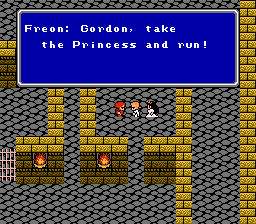 FRIONIEL
FRIONIELA courageous youngster oprhaned during the empire's assault on Phin. After getting rescued by Hilda and taken to Altair, Frioniel agrees to aid the rebel forces by performing important reconaissance missions and fetch quests.
Frioniel is your standard virtuous JRPG "Hero" archetype; a precursor to characters like Bartz, Locke, Zidane, Tidus, etc. Unlike his later counterparts, however, Frioniel isn't an alien, a clone, a basket case, or a dream, and doesn't have any skeletons in his closet, because this was before those sorts of gimmicks were necessary. "Frioniel" appears to be his actual name, but it was changed to "Firion" in the American releases due to space restrictions. For my playthrough, I dubbed him "Freon," after the ozone-damaging chlorofluorocarbon.

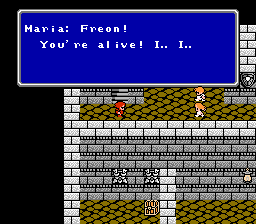 MARIA
MARIAAnother orphaned refugee and close friend of Frioniel, Maria represents the "kind-hearted, frail-of-body-yet-strong-willed female lead" who reappears in later games as Rosa, Lenna, Terra, Celes, Aeris, Rinoa, Dagger, Yuna, etc. I don't think there's much else to be said about Maria, other than the fact that she boasts one of the nicest 8-bit racks in existence (for whatever the hell
that's worth).

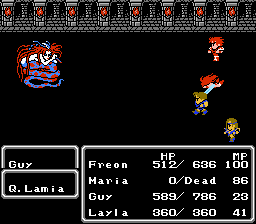 GUY
GUYFrioniel and Maria's lovable lunkhead pal is an instance of the "gentle giant" archetype, later seen as Sabin, Barrett, Kimarhi, etc. His special powers include the ability to communicate with beavers and [REDACTED] strength.

 LIONHEART
LIONHEARTMaria's older brother goes missing after the group wakes up in Altair and does not reunite with his sister and friends until the end of the game. Lionheart is a double prototype -- in addition to being the first instance of the Dark Knight class in
Final Fantasy, he's also the first "bad good guy" character, followed by the likes of Kain, Shadow, Vincent, Amarant, and so on. He has been renamed "Leon" in the official American releases, which isn't nearly as striking as "Lionheart." I personally like to call him "RASTA."

 MINWU
MINWUPrincess Hilda's right hand man and White Mage extraordinaire. Nobody can agree on his name; Square romanizes it as Ming-Wu, the Neo Demiforce fan translation (featured in the screenshots) calls him Minh, and he appears as both Mindu and Minwu in the English versions of
Final Fantasy Origins and
Dawn of Souls. In any case, he's the first temporary ally to join the team, and the closest thing you get to a genuinely useful one due to his extensive White Magic grimoire. It's to say which later characters in the series resemble him, since most (all) future White Mages are female.

 JOSEF
JOSEFThe mayor of the wintry village of Salamando serves as both a "bare handed fighter" and a "middle-aged/geezer hardass" archetype, which makes him the precursor to Yang, Galuf, Sabin, Strago, Tifa, Zell, Amarant, Steiner, and a whole bunch of future Cids. He lends the party his Ice Sled, which they are then forced to lug around for the rest of the game after using it twice.

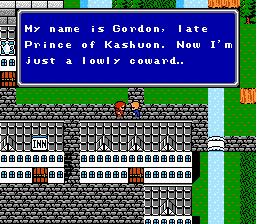 GORDON
GORDONA "spoony, mopey, loser prince" kind of person; reappears as Edward in
Final Fantasy IV and is rarely seen afterward because nobody really
likes this kind of character. Eesh. Gordon is the former prince of the decimated kingdom of Kashuon, and eventually mans up and leads the rebellion at Hilda's side. He's actually not such an awful character once you power him up a bit, but...well, more about that later.

 LAYLA
LAYLAThis spunky pirate chick is your "sassy beauty with a mean streak" character, who later appears as Faris, Yuffie, Lulu, and Paine. Like several of her descendents, she ends up joining the good guys after a failed attempt at kidnapping and robbing them. Like Maria, Layla flaunts her 8-bit cleavage when she's low on HP or suffering from a status ailment, but the novelty has probably worn of by the time you find her.

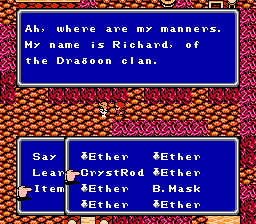 RICHARD
RICHARDEven if he can't jump, the Dist Kingdom's last surviving Dragoon is the very first appearance of one of
Final Fantasy's most popular warrior classes. How's that for impressive credentials? Richard comes across as a "noble warrior with an air of tragedy" kind of person like Cyan, Freya, and Auron. He has the ability to communicate with and ride the Hiryuu, a type of dragon that usually gets translated as "wyvern" or "wind drake" in the American releases.
Villains
IMPERIAL FORCESThe infernal legions of Palamecia, summoned from Hell itself by the Emperor's magic. While they are humanoid in appearance, their strength, durability, and mercilessness exceed human limits. Unless you have a death wish, it's usually a bad idea to try talking to them.
THE DARK KNIGHT
A mysterious and powerful warrior who swiftly rose through the imperial ranks to become one of the Emperor's most trusted servants. Maria can't help feeling (and remarking) that she's heard his voice before, so you probably shouldn't have much trouble guessing his true identity.
BORGAN
A cowardly traitor from Phin who helped hand the city over to the empire. Borgan makes a lot of noise, but is a complete wuss in battle. Several hours after you kill him off, he unceremoniously reappears in the final dungeon as a zombie in one of the funniest (and most morbid) moments in the whole series.
GOTUS
The leader of the imperial forces occupying Phin. Another wimp.
THE EMPEROR
The ruler of Palamecia and the villain who begins the
Final Fantasy tradition of "evil power-hungry despot who attempts to harness an ancient/sealed/forbidden/dark force in order to take over the world but is then consumed by said force" that has since become an ingredient in the plot of nearly every JRPG from the last twenty years. You know how it goes. At least the Emperor keeps it fairly straightforward and just sells his soul to the devil. He's such a nasty person that when he dies and goes to Hell, seizes control of the place and brings a piece of it to Earth to continue his reign of terror.
Other Characters
HILDA
Phin's exiled princess leads the rebellion from the town of Altair in place of her wounded fiancee and father. As you can see,
Final Fantasy II retains a "Lord British" figure, but casts him as an attractive young woman instead of a crusty old beard. Pretty much the whole game consists of following the orders Hilda barks at you from her throne. "We need Mythril to compete with the Imperial Army! Go find some!" "The Empire's Warship will kill us all! Go deal with it!" "Now we need Ultima magic! Snap to it!" "AIIEE! Now the Emperor's summoned a tornado! Fix it!"
PAUL
Phin's master thief and ninja dude. Paul appears several times throughout
Final Fantasy II, but never actually joins the team. It's a shame, since he's cooler and clearly more competent than most of the losers who do.
CID
The very first appearance of a character named Cid in a
Final Fantasy game. He seems to be based at least somewhat on Han Solo: he's a roguish, foul-mouthed, free-spirited pilot who provides the rebels with transportation (at a price). He's a decent enough guy, but apparently racked up some pretty awful karma earlier in life: after
Final Fantasy II, Cid endures nearly two decades of repeated reincarnations as weird old coots.
ELINA AND CHILD
The wife and son of a slain Dragoon. They wouldn't be worth mentioning were it not for the fact that that
Final Fantasy Origins does some retconning and changes the previously unnamed child's name to "Kain." Richard, whose last name is "Highwind," adopts the boy later on in the game. This suggests that the kid grows up to be Kain Highwind of
Final Fantasy IV fame, which is Squeenix revisionary garbage and you shouldn't believe it.
CHOCOBO
Final Fantasy's ubiquitous ratite has its unassuming beginning here as a useful device for traversing the world map without having to worry about random enemy encounters. Keeping true to Kawazu's style, there is only one Chocobo Forest in the whole game, not a single character ever mentions it, and it occupies a single inconspicious forest tile that you probably won't ever wander into.
LEVIATHAN
Final Fantasy's renowned ocean deity makes his first appearance here. But before Leviathan became a summon spell, he was a dungeon. The giant serpent swallows the party's ship whole on their way to the Mysidia Tower, forcing our heroes to stage an escape from his monster-filled belly before they can continue their quest.
THE ENTRANCE TO HELL LIES BEYOND THIS PATH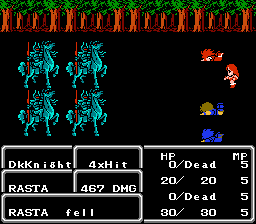 Final Fantasy II
Final Fantasy II starts off with Frioniel and friends locked in a hopeless struggle against an imperial death squad. There is no way to win. No matter what you do, your team gets the mortal shit kicked out of it. This is a perfectly appropriate introduction, inasmuch as it sets the mood for everything else to come. Kawazu's brainchild is a games that does everything it can to break you down and wither your spirit. And when I write "you," I am not referring to your in-game player characters. I'm talking about
you, the player.
Final Fantasy II is a pair of simultaneous battles on two separate planes. The first is the fictional struggle of Frioniel and the rebel forces against the might of the Palamecian Empire. The second is the very real battle between you, the player, and
Final Fantasy II in which the game attempts to foil your efforts and demoralize you from ever playing again. As you try to beat
Final Fantasy II, Final Fantasy II tries to beat
you.
Most
Final Fantasy II reviews and FAQs only describe the first aspect of this struggle. Today, we shall discuss the latter. To this end, I have pinpointed the
five primary devices with which Kawazu equipped
Final Fantasy II to help it succeed in its psychological battle against the player's will.
1.) Ludicrous Stat/Ability Progression System
Kawazu as a game designer is a little bit like Charles Manson as a musician: his work is difficut to enjoy, but you can't fault him for a lack of imagination. While it took the rest of the gaming world another twenty years to start griping about the JRPG going stagnant, Kawazu was hankering to stir around the formula as far back as 1988. To this end, he designed
Final Fantasy II as an RPG with no experience points and no character levels. Progressive, right? Problem is, Kawazu's alternative is worse. So much worse. It renders
Final Fantasy II unplayable to the point where I have a hard time believing it wasn't intentional.
Here's how it works: your statistics increase with use. If you use a lot of physical attacks in battle, your character's attack stat and weapon skill level increase. If you use a lot of magic, his intelligence or spirit (depending on whether he uses black or white magic) increase. Losing a lot of health in battle means your character's HP total and vitality increase, while using up a lot of magic points might lead to an increase in his MP. (I say "might" because there's no guarantee that you will receive a stat increase after a battle.)
In practice, this means (as I hinted at earlier) is that the most efficient way of building up your party's HP, attack, vitality, and weapon skill levels is to go into battle against a bunch of weak monsters and, instead of fighting the them, order your team to whale on themselves and each other as their foes flee in confused terror. I will have Maria demonstrate:
STEP ONE: Maria targets herself.
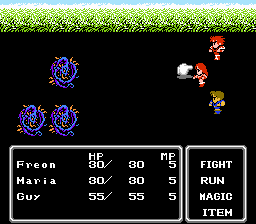 STEP TWO
STEP TWO: Maria clubs herself over the head.

 STEP THREE
STEP THREE: Party defeats enemies.
 STEP FOUR
STEP FOUR:For clubbing herself in the head, Maria is rewarded with more HP.

But it doesn't stop there.
Final Fantasy II uses a magic/weapon skill system similar to the one used later on in the
Mana series. Regularly using a certain type of weapon increases a character's proficiency with that weapon, allowing them to score more hits and inflict higher damage. Casting the same spell enough times levels it up, boosting its effectiveness. The problem lies in the frequency with which you must use a weapon or spell to see a skill increase. It takes 100 skill points to level up a weapon or spell, and each use is only worth only one or two points. (Perhaps "one to two points" would be a better way of putting it.)
This isn't too much of a problem with melee attacks, but it makes using magic in
Final Fantasy II a grueling ordeal. When you buy that Fire spellbook and give it one of your party members, it starts off at level one. In order to level it up to two, you must cast Fire in battle anywhere from fifty to a hundred times. Getting it up to level three after that necessitates another fifty to a hundred uses. And if you have any interest in using Ice or Bolt magic, you'd better begin leveling up
those too. The Heal and Blink spells are useful as well: START LEVELING. Holy? Flare? Ultima? All start out at level one, and need to reach level five before becoming even remotely useful in the late stage of the game in which you acquire them. That's 250 to 500 uses. Each.
But never fear! There
is a shortcut to boosting your spell levels. Due to a bug in the game, selecting a target for a spell registers as a successful use of said spell. This allows you to farm skill points by selecting a spell, choosing a target, then pressing "B" to cancel the command and doing it over again. Repeat fifty to a hundred times for an increase in that spell's level. The process is a lot like doing reps at the gym: tedious, repetitive, and time-consuming, but without any
tangible results. If your brain releases
any endorphin during this process, I would contact a neurologist immediately.
Lastly: two very important stats are agility and evade, since they determine whether your team can run away from a fight. They are increased when a character successfully dodges a physical attack, which itself is a roll of the dice based on a few percentages. During this playthough, my party members had exceptionally bad luck dodging attacks because I didn't give them shields (my reasoning was that shields decrease the potency of physical and magical attacks), so their agility and evade stats rarely increased. As a result,
I was never able to run from any battles. Ever. Every time -- I cannot possibly stress the word "every" enough -- a random battle came up, I had to deal with it. If the battle between myself and
Final Fantasy II were a boxing match, this would be the equivalent of getting kicked repeatedly in the balls with a steel-toed boot.
Addendum 1: After playing around with
Final Fantasy II and a savestate editor, I've found that it's impossible to run from a grossly large number of enemy configurations even when your whole team's agilty and evade are cranked up as high as they can go.
Addendum 2: I forgot to mention that an increase in physical stats commonly causes your characters' magic stats to fall, and vice versa.
Schade!
2.) Doors to Nothing
The dungeons in the original
Final Fantasy have doors. They have many doors. Behind these doors are rooms. Often, these rooms contain stuff. It is usually a good idea to check behind doors in
Final Fantasy.
Final Fantasy II's dungeons also have doors. They have many doors. They have more doors than the dungeons in
Final Fantasy. But most of the time, there is
nothing behind them. They usually lead to totally empty rooms. Neat, huh?
It gets better: when you enter the room and the screen changes, your character is positioned several paces inside. In a game where every step is a potential enemy encounter, and fleeing from battle can be anywhere from difficult to downright impossible (did I mention that you can't retreat from undead foes, and most dungeons are full of them?), this can be much more of a pain than it sounds. The obvious solution is to just not go through any doors, but then
Final Fantasy II will throw curveballs by hiding an extremely crucial and rare piece of equipment or placing the staircase to the next floor behind a single nondescript door among six others. The only thing that could possibly make dungeon exploration in
Final Fantasy II more agonizing would be if stepping into an empty room caused the voice of George W. Bush to cackle over the speakers. "HEH HEH! NO WEAPONS OF MASS DESTRUCTION IN HERE!"
3.) Useless Allies
So you have three primary party members: Frioniel, Maria, and Guy. They remain with you for the entire game and are worth building up as much as possible. The fourth party member slot goes vacant and gets filled as the progression of the plot demands.
The first ally you get is Minwu, who knows almost every white magic spell in the game at fairly high levels. Minwu is a very helpful addition and does a good job helping you team stay afloat during the first areas of the game.
Then you get Josef. Josef doesn't know any magic, but has a decent amount of HP and attack power, so he's pretty good to have around.
And
then you get Gordon, who is a total wimp. His stats are pitiful, he's unskilled with weapons, and he doesn't know any spells. Making him useful even to the smallest degree requires time and effort (ie: spending an hour or two of your life making him spear himself in the head). When Gordon he leaves your party, he's replaced by Layla, who has low HP, low weapon skill levels, and knows only one spell. Gotta power her up, too. Later on, you get Richard, who has lousy HP, so-so attack power, and no spells. Get the gist yet?
Sure.
Final Fantasy II might be the first game in the series to feature characters with backgrounds and personalities, but what difference does it make if most of them can't pull their weight in battle? Jerks.
4.) Limited Inventory Room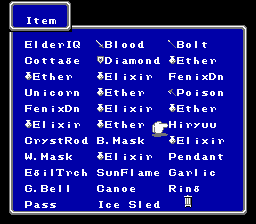
This is nothing new. The original Final Fantasy' inventory system was very restrive, limiting your party's equipment to what its members could lug around: four weapons and four pieces of armor each. Of course, there was also that separate menu for the game's six disposable items, each of which could be stocked up to ninety-nine.
Final Fantasy II ditches this system for an inventory consisting of thirty-two slots while throwing piles and piles of new items into the game. Many of these are story-related "key" items that have no practical purpose but to progress the plot at certain points and are impossible to throw away or hand off. By the time you're at the final dungeon, a third of your inventory -- space you could really use for all the Elixirs, Ethers, Phoenix down, and other stuff your team needs in order to survive Jade and Pandemonium -- consists of worthless garbage that the game won't let you get rid of. It even drops Richard's dragon (which can presumably bite, claw, and breathe fire at foes if it wanted) into your stash as an unusable weight, apparently just to taunt you.
5.) Wild Goose Chases
Okay. Here's how an early chunk of
Final Fantasy II plays out:
STEP ONE: Talk to Hilda in Altair. "WE NEED MYTHRIL! GO TO THE SEMITT CAVE NEAR SALAMANDO AND GET SOME!"
STEP TWO: Leave Altair. Take the canoe across the lake. Enter Palm. Pay the man in Palm to take you to Poft in his ship. Pay Cid in Poft to take you to Salamando in his
airship.
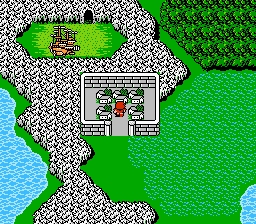 STEP THREE:
STEP THREE: Enter Salamando. Talk to Josef. Exit Salamando. Walk to the Semitt Cave. Enter Semitt Cave, fight your way to the bottom, acquire the Mythril.
STEP FOUR: Exit the Semitt Cave. Walk to Salamando. Talk to Josef. Exit Salamando. Walk to Poft. Pay the man in Poft to talk you to Palm in his ship. Exit Palm. Take the canoe across the lake. Enter Altair. Talk to Hilda.
STEP FIVE: Hilda: "NOW GO TO BOFSK AND STOP THE EMPIRE'S WARSHIP!"
STEP SIX: Exit Altair. Take the canoe across the lake. Enter Palm. Pay the man in Palm to take you to Poft on his ship. Pay Cid in Poft to take you to Bofsk in his airship.
STEP SEVEN: Enter Bofsk. Sneak into the sewers. Fight many battles. Get to the end of the sewers, watch a brief exchange, retrace steps back out.
STEP EIGHT: Exit Bofsk. Walk to Poft. Pay the man in Poft to take you to Palm on his ship. Exit Palm. Take the canoe across the lake. Enter Altair. Talk to Hilda.
STEP NINE: Hilda: "TALK TO CID! MAYBE HE KNOWS HOW TO STOP THE WARSHIP!"
 STEP TEN:
STEP TEN: Exit Altair. Take the canoe across the lake. Enter Palm. Pay the man in Palm to take you to Poft on his ship. Talk to Cid in Poft.
STEP ELEVEN: Pay the man in Poft to take you to Palm on his ship. Exit Palm. Take the canoe across the lake. Enter Altair. Tell Hilda what Cid told you.
STEP TWELVE: Hilda: "BUT IN ORDER TO ENTER KASHUON CASTLE AND ACQUIRE THE SUN FLAME, YOU'LL NEED THE GODDESS BELL! GO TALK TO SALAMANDO AND ASK JOSEF ABOUT IT!"
STEP THIRTEEN: Exit Altair. Take the canoe across the lake. Enter Palm. Pay the man in Palm to take you to Poft on his ship. Pay Cid in Poft to take you to Salamando in his airship. Enter Salamando. Talk to Josef.
STEP FOURTEEN: Josef: "YOU'LL NEED AN ICE SLED TO REACH THE DUNGEON WHERE THE GODDESS BELL IS KEPT! BUT AS LUCK WOULD HAVE IT, I'VE HIDDEN ONE IN A SECRET ROOM IN THE SEMITT CAVE!"
STEP FIFTEEN: If your will somehow remains unbroken and the game is still turned on at this point,
Final Fantasy II will begin administering electrical shocks through the
controller.
CONCLUSION!
As a game,
Final Fantasy II is rotten. But as an artifact, it's sort of interesting. What we have here is an old-school
Final Fantasy game that has more in common with its distant descendants than any of its NES or SNES bretheren. It ditches character classes, elemental crystals, and strives for an atmosphere of gritty realism (as much of one that the NES can allow, anyway). It tweaks the JRPG conventions to an extent that we don't see again until
Final Fantasy VII or
VIII, and predicts virtually all the stock character archetypes we'll be seeing in every sequel for the next twenty years. It introduces just as many -- if not more -- of the iconic
Final Fantasy terms, items, spells, and creatures than the original game. You'd be hard-pressed to find a
Final Fantasy title with a farther-reaching influence within the series than
II.
But don't think for a moment that you should actually
play it. That would be absurd. Even if you're a numbers-obsessed gaming masochist or a hardcore Square fan, I would still be loath to recommend a run through
Final Fantasy II. Read a FAQ instead. Watch a Let's Play. Browse the Wiki. But
don't play it. There are hundreds of other games that are more worth your time, and that won't compel you to club yourself in the head.
Ugh. I need a fistful of asprin and a shower.




